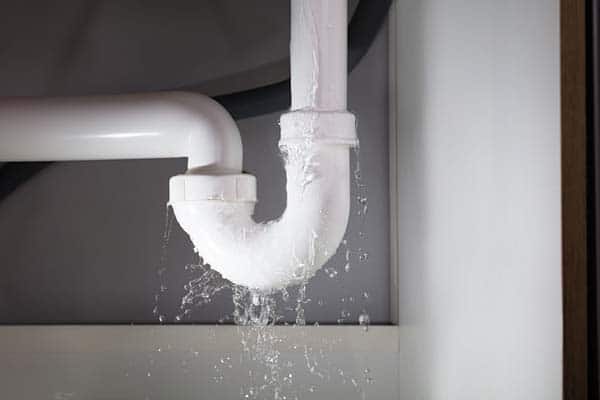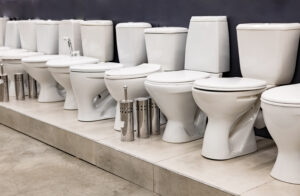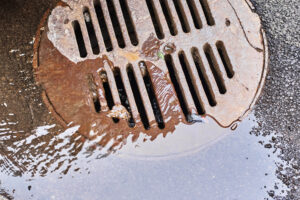Burst pipes are one of the biggest plumbing emergencies a home or property can face. They can strike suddenly, catching you off guard, or develop quietly over time, often going unnoticed until the pipe bursts.
The consequences can be costly and stressfu,l but the good news is that with the right knowledge (and some quick action), you can minimise damage, stay in control, and protect your property. This guide is designed for homeowners, renters, and property managers alike, walking you step by step through everything from immediate responses and temporary fixes to knowing when and how to call in professional help. By the end, you’ll know exactly what to do when a burst water pipe strikes.
· Act fast: Shut off the main water valve and electricity immediately to prevent extensive flooding and dangerous electrical hazards.
· Apply temporary fixes like pipe tape or epoxy putty to control leaks until professional plumbers arrive for permanent repairs.
· Call licensed emergency plumbers within the hour, as DIY solutions are temporary and proper diagnosis prevents future failures.
· Dry affected areas within 24-48 hours to prevent mould growth and document all damage with photos for insurance claims.
· Install pressure-reducing valves and insulate exposed pipes to prevent future bursts from high pressure and freezing temperatures.
What Causes Burst Pipes?
Burst pipes can happen for a number of reasons. Some are obvious, others less so. But many causes are preventable with proper care and maintenance. Understanding the factors that put your pipes at risk is the first step in protecting your home or property. Some of the most common causes are:
1. High Water Pressure: Excessive water pressure puts constant stress on your pipes, which weakens them over time. This can result in leaks, cracks, and eventually bursts. Issues like faulty pressure regulators or sudden water hammer (the banging noise in pipes) can make the problem worse, accelerating damage.
2. Corrosion: Older metal pipes are particularly vulnerable to corrosion. Over time, the pipe walls can weaken or rust, making them more likely to burst. The chemical composition and pH balance of your water can also contribute to corrosion, especially if it’s highly acidic or contains certain minerals.
3. Wear and Tear: All pipes naturally degrade over time. Age, repeated use, and long-term exposure to water pressure can gradually weaken the plumbing system, increasing the likelihood of a burst.
4. Poor Installation: Pipes that were installed incorrectly, such as using the wrong size, improper joints, or insufficient support, can create weak points in your system. Even new pipes can fail prematurely if installation standards aren’t met.
5. Ground Movement: Shifting soil, construction work, or even minor earthquakes can place stress on your pipes. Movement of the ground can bend, twist, or crack pipes, making them more susceptible to sudden bursts.
6. Root Intrusion and Blockages: Tree roots can infiltrate underground pipes, while debris and blockages inside pipes increase pressure and strain. Both of these issues can ultimately lead to pipe bursts if left unaddressed.
Signs Of A Burst Water Pipe
Spotting the early warning signs of a burst water pipe can save you from extensive water damage and costly repairs. Pipes can give various signals before a full failure occurs. Here’s what to watch for, both inside and outside your home.
Inside Your Home
Keep an eye out for these common indicators of a burst pipe:
· Unexpected water stains: Dark patches on walls or ceilings often signal hidden leaks.
· Unusual sounds: Hissing, bubbling, or whistling noises when water runs can indicate a problem.
· Musty odours or discoloured water: Brown or rusty-tinted water is a warning of corrosion or leaks.
· Peeling paint or wallpaper: Bubbling or warped surfaces suggest moisture behind walls.
· Unexplained increase in water bills: Sudden spikes despite normal usage can be caused by hidden leaks.
Outside Your Home
Outdoor pipe bursts require different detection methods. Watch for:
· Persistent wet patches: Lawns or driveways that stay damp even during dry weather.
· Water pooling: Unexpected puddles in your yard with no obvious source.
· Soggy ground or sinkholes: These may indicate underground pipe failure.
· Ice formation in cold weather: Leaks can freeze, forming visible ice patches.
· Water meter test: Turn off all water, check your meter reading, wait 30–60 minutes, then check again. A different reading means there’s a leak somewhere.
Low Water Pressure
A sudden drop in water pressure is often a sign that water is escaping through a burst pipe. Watch for:
· Multiple fixtures are experiencing low flow at once.
· Dramatic or sudden pressure changes.
· Running water sounds when all taps are off.
Systematic Wet Spot Checks
Inspect areas prone to hidden leaks, such as:
· Under sinks and around appliances.
· Along basement or utility room walls.
· Behind toilets and shower areas.
What To Do After a Pipe Burst
Step 1: Shut Off Water and Electricity
A burst water pipe can cause extensive damage to your home. Quick action now could save you thousands in repair costs later.
Identify the Problem and Assess the Damage
Your safety comes first before any repairs begin. You need to find the leak source and check how far the water has spread, especially around electrical systems and structural elements. Get a full picture of the damage by checking your walls, ceilings, floors, and nearby structural parts.
Don’t forget to take photos of major leaks for your insurance claims!
Locate the main water shut-off valve
You can stop water damage by finding and turning off your main water valve right away. Most Australian homes have this valve in these locations:
· Near the water meter at the front of your property (often under a council cover plate)
· Close to the garden tap or property boundary
· In apartments or units, typically under the kitchen or laundry sink
Turn the valve clockwise (to the right) until it closes completely. A stiff valve might need pliers or a wrench – just use gentle pressure to avoid breaking it. Check if the water is really off by turning on any tap inside; no water should come out.
Turn off power in affected areas (and why)
Water and electricity create dangerous safety risks together. If water leaks near electrical outlets, appliances, or power points, shut off electricity to those areas from your main switchboard immediately. You should turn off the power to the entire house if flooding is extensive.
Look for the main electrical switchboard near the front entry, hallway, or outside your home. The main circuit breaker, labelled “main switch”, controls all power and lighting circuits – switch it off to cut power completely.
Ensure safety before entering wet zones
Your personal safety matters more than property damage. Before you step into flooded areas, make sure:
☐ You’ve turned off all electricity
☐ The structure is still stable
☐ You wear proper protective gear, especially around contaminated water
☐ You watch out for slippery wet floors
The risk drops substantially after you’ve turned off both water and electricity. Only then should you move on to containing and fixing the damage.
Step 2: Contain the Burst Pipe Water
The first step after turning off water and electricity is to control and contain water from your burst pipe. Quick action will substantially reduce water damage to your home’s structure and belongings.
Use buckets and towels to catch water
Place large buckets right under the burst pipe to collect escaping water. Keep extra buckets close by to swap them out when they fill up. This prevents overflow and stops water from pooling further. You’ll need to watch the buckets until your plumber shows up.
Grab towels, mops, and sponges to soak up water from floors and affected areas. This stops water from reaching other parts of your home and cuts down the risk of structural damage and mold. You need to move fast because standing water soaks into floors, walls, and furniture faster than you’d expect.
Pro tip: Let fresh air flow through the affected areas by opening doors and windows. This helps everything dry out and prevents damage like corrosion or warping.
Drain the remaining water from the taps
Even after shutting off the main water supply, your plumbing system still contains water that can leak through the damaged pipe. To prevent further damage, it’s important to drain the remaining water and relieve pressure throughout your system.
Start by opening taps at the highest points in your home and work your way down. This allows water to flow out while letting air enter the pipes for better drainage. Focus on cold water taps first, then open hot water taps to systematically clear all water lines and reduce internal pressure.
Pressure buildup can worsen leaks or even cause additional pipes to fail, so draining water naturally relieves most of it. Don’t forget to check appliance manuals—modern dishwashers and washing machines often have emergency drain functions to remove standing water safely.
Step 3: Apply Temporary Fixes
You’ve contained the water from your burst pipe, and now a temporary fix can give you precious time until a professional arrives. These emergency measures aren’t permanent solutions, but they can substantially reduce water damage to your property.
Use pipe repair tape or clamps
Pipe repair tape gives you a quick, temporary fix for a burst water pipe. Self-amalgamating or silicone tape creates a waterproof seal when you stretch and wrap it around the damaged area. This special tape fuses to itself and forms a solid rubber band over the leak, even under pressure.
Here’s how to make it work:
1. Clean the pipe’s surface
2. Stretch the tape as much as possible (without breaking)
3. Wrap it tight around the leak, overlapping each turn
4. Keep wrapping until the leak stops
Pipe clamps are another option that provides strong temporary sealing for straight pipe sections. You can create a watertight seal by placing a rubber patch over the leak and securing it with a hose clamp or specialised pipe clamp until permanent repairs happen.
Apply epoxy putty for small cracks
Epoxy putty works great for smaller cracks and pinhole leaks in your burst pipe. This two-part adhesive (resin and hardener) creates a watertight seal after it cures.
Here’s how to apply it right:
1. Cut enough putty to cover the damaged area
2. Knead it until you see a uniform colour (usually 1-2 minutes)
3. Apply it to a clean, dry pipe surface
4. Press it firmly into the crack or hole
5. Shape and smooth with wet fingers if needed
Most epoxy putties stay workable for 5-10 minutes before they harden and become strong enough in about 60 minutes. Full curing takes 24 hours.
Temporary fixes aren’t always enough
These emergency solutions help, but they won’t permanently fix a serious burst water pipe. Keep in mind that:
· High-pressure leaks might break through tape or putty repairs
· Major pipe damage needs professional replacement
· Corrosion under temporary fixes spreads
· You can’t use water-contaminating materials on drinking water pipes
Some situations need a plumber right away instead of DIY repairs. These include:
· Multiple leaks showing systemic pipe failure
· Bursts you can’t reach
· Leaks affecting electrical systems or structural parts
· Water pressure you can’t turn off
These fixes are just temporary until professional plumbers can implement lasting solutions. Your next step should be to call qualified professionals, like the team at GA PERRY, who can give you a full picture of your burst pipe situation and fix it properly.
Step 4: Call a Burst Pipe Plumber
While quick fixes can help control a burst pipe temporarily, professional help is essential for a permanent, safe repair. Licensed plumbers have the expertise, tools, and parts to restore your plumbing system properly and prevent future problems.
When to call a professional
You just need immediate professional help in certain situations, whatever your DIY skills:
· Hidden leaks behind walls or above ceilings
· Leaks that keep coming back after temporary fixes indicate deeper problems
· Water damage visible on walls, ceilings, or structure
· Leaks close to electrical wiring or gas lines create safety risks
· Multiple leaks showing system-wide pipe problems
What to expect during emergency pipe repair
Professional plumbers first get a full picture of the damage to find both the burst pipe and why it happened. They use special leak detection tools to find exact spots, even with hidden leaks.
They’ll talk through repair options and costs upfront after the diagnosis. Most emergency plumbers carry common parts and tools to fix things right away. They might put temporary fixes in place for complex problems before coming back with specialised equipment.
At GA PERRY, our fully licensed and insured local plumbers in Perth are ready to tackle everything from burst pipes to blocked drains, quickly and efficiently.
Step 5: Clean Up and Prevent Future Damage
Now it’s time for the clean-up. Removing standing water, drying affected areas, and addressing hidden moisture are crucial to preventing mould, structural damage, and long-term issues.
Start by mopping up or using a wet vacuum for water on floors, then ventilate the space with open windows, fans, and dehumidifiers to speed up drying. Inspect walls, ceilings, and furniture for dampness or discolouration, and document any damage with photos for insurance purposes.
Next, take steps to protect your home from future pipe bursts. Consider installing pressure-reducing valves, insulating exposed pipes in cold areas (if pipe are prone to freezing), and scheduling regular plumbing inspections. Proper clean-up and preventive measures will help your home recover faster and reduce the risk of another emergency.
Key Takeaways
A burst water pipe can cause serious damage if not addressed immediately. Recognising the warning signs and shutting off your water and electricity should always be your first steps. Containing leaks with temporary fixes like repair tape, clamps, or epoxy putty can help, but these measures are only short-term solutions.
Calling a licensed emergency plumber quickly is essential—they have the expertise and tools to provide lasting repairs while identifying the root cause of the problem. Equally important is thorough cleanup and drying of affected areas to prevent mould, corrosion, and structural damage, followed by a professional inspection of your plumbing system.
Being prepared makes all the difference. Knowing where your main water valve is and having emergency plumber contacts on hand ensures you can act fast when every minute counts. At GA PERRY, our licensed plumbers are available 24/7 to respond quickly to burst pipes, helping you minimise damage and restore your home safely and efficiently. Call today!




